
Cristian
Willemoës
8" f/6 Reflector Starfinder Meade
20-second exposure. Faked color.
Kodak Tri-X 400 ASA a 3200 ASA
SUMMARY:
The general features of
the process will be described so that everyone will be able to define
the method, kind of film, time of exposure and developer solution that
best adapt to each equipment. All the illustrations herein have been
made with Kodak black and white Tri-X (400 ASA) and processed according
to the text (3200 ASA and 6400 ASA). All the objects in deep space have
been taken on 20-second exposures prime- focus, using a 200 mm Meade
Starfinder telescope, in a highly polluted urban sky.
THE PROCESS IN THREE MAIN PHASES:
1) Expose the film to a speed 8 times faster than the one recommended
by the manufacturer. For example, a Plus-X film should be picked up
from 125 ASA to 1000 ASA and a Tri-X film should go from 400 ASA to
3200 ASA. Now, according to my experience, only 20 seconds are needed
when using a 200 mm f/6 telescope for spotting deep space objects at
a prime-focus. However, this lapse can be lessened by increasing the
process sensibility. For brighter bodies like the Moon, the sensibility
range on the light meter must be taken to 3200 ASA in order to speed
up the shot. Thus, the film will not be overexposed. For deep space
bodies, cover the telescope with any dark element, then shoot. After
that, the dark element must be removed from the telescope for 20 seconds.
Cover the telescope once again and finally close the drop shutter. The
telescope must not be touched at any moment in order not to produce
any vibration that may alter the image. Due to the minimal exposure
achieved through this method, a great number of photos can be taken
in one single night. That is to say, 1 or 2 full rolls which will be
developed together at the end of the session.
2) Prepare the D-76 concentrated
developer solution. It is U$S 5 per 1 liter of concentrated solution,
good for developing between 22 and 30 rolls, depending on the kind of
forcing applied and the tank capacity. The formula is: 1 part of concentrated
solution + 4 parts of water.
3) Develop the film with
the prepared solution, and increase the periods suggested by the manufacturer
to five times. (20�C for 40 minutes). Then, wash the negative fully
and fix it the usual way. You will notice a negative with the proper
density and a quality higher than normal, perfect definition and contrast,
great degree of tone, and fine grain.
One of the most outstanding features is the abundance of details, either
at high or at low lights. All these characteristics can only be met
with a fine grain film like Plus-X and Tri -X by Kodak and a developer
like D-76 by Kodak, the so-called compensators.
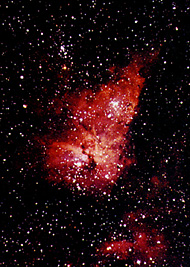 Eta
Carinae Nebula
Eta
Carinae Nebula
Binnewies, Riepe y Sporenberg
11" f/7 Celestron
85-minute expo- Hipered Kodak Ektar 100 ASA |
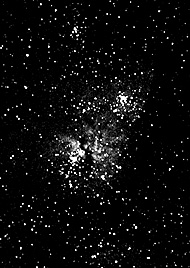 Eta
Carinae Nebula
Eta
Carinae Nebula
Cristian Willemoës
8" f/6 Reflector Starfinder Meade
20-second exposure
Kodak Tri-X 400 ASA a 3200 ASA |
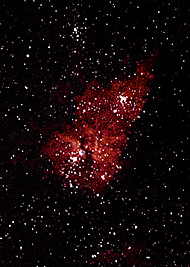 Eta
Carinae Nebula
Eta
Carinae Nebula
Cristian Willemoës
8" f/6 Reflector Starfinder Meade
20-second expo - Faked color Kodak Tri-X 400 ASA a 3200
ASA |
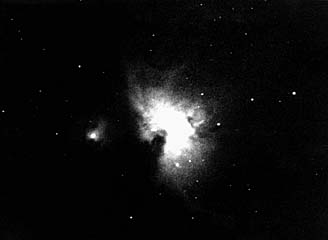 Orion
Nebula
Orion
Nebula
Cristian Willemoës
8" f/6 Reflector Starfinder Meade
20-second exposure
Kodak Tri-X 400 ASA a 6400 ASA |
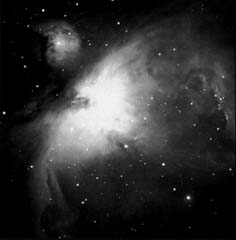 Orion
Nebula
Orion
Nebula
Claudio Bottari
Astro-Physics 7" f/9, Filtro Hidrógeno Alpha, N. B.
6-minute exposure
CCD Camera Spectra-Source HPC-1 |
HOW
TO PROCESS THE FILM YOURSELF
It
is easy to calculate the relation among the increase of sensibility,
dilution of the drug and developing time. You just need to add as many
parts of water to the concentrated solution as points of ASA at which
the exposure has been modified + 1 more part of water
|
|
As
these recommendations from the manufacturer show, for a 400 ASA
Tri-X film you need 8 minutes of development (with D-76 developer
solution) at 20�C. But if you increase the sensibility, you will
have to raise the parts of water, according to the points of ASA
increased as well, + 1 more part of water.
Then, multiply this total by the suggested time.

....at
20º C = 8 minutes x 5 times = 40 min
|
Here
is another example: Let�s say the object to be photographed is extremely
weak and we prefer to darken the negative a bit more, developing at
6400 ASA, the formula will then be:

.at
20º C = 8 minutes x 6 times = 48 min
For
all cases, at the beginning of the process, the tank must be churned
continuously for 2 minutes. Through this, all the bubbles will be utterly
removed. You must repeatedly shake the tank for 1 minute and let it
rest for ten minutes more until the end of the procedure, so that the
developer is constantly renewed.
OTHER
HIGHLIGHTS
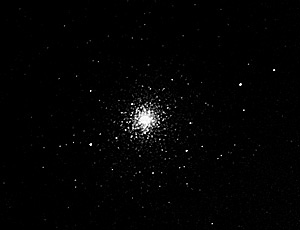 47
Tucanae
47
Tucanae
20-second exposure to 6400 ASA. C.W.
|
The
goal of this method is to obtain the most suitable negatives to
be copied and to avoid the use of professional processing laboratories
for the negatives, then you can use negative-scanners to produce
an outstanding result. You can also copy the negatives on paper
and later on, scann them the usual way.
All the pictures in this article have been
copied in a homemade amplifier and then scanned and processed
on a computer.
|
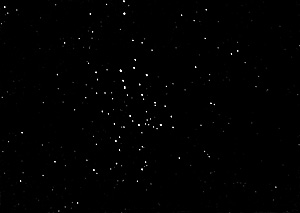 M6
M6
20-second exposure to 3200 ASA. C.W. |
As
you can see, the reduction of the time of exposure is remarkable,
even though the main cost of the procedure is given by the long
development time. Yet, this cost is not substantial in relation
to the development temperature and the procedure itself. On the
contrary, it may well be more than convenient: in 40 to 50-minute
developments, the variations in temperature are not significant,
The same applies to the time you take in replacing the developer
for the fixer. On the other hand, these might alter those negatives
developed during shorter periods of time.
|
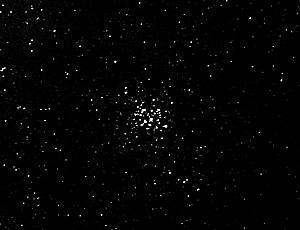 NGC
3293. 20-second exposure to 3200 ASA. C.W.
NGC
3293. 20-second exposure to 3200 ASA. C.W. |
Shaking
the tank during the developing process may result in a problem
for regular developments due to the long time it takes the drug
to become active. Another consideration is the economical benefit
derived from the chemicals to be used, especially the developer,
since the drug is greatly diluted.
You should dispose the developing solution
after each process, but you do not need to do this with the fixative.
|
I
recommend heating the developer solution 5�C more during the process,
using stainless tanks instead of plastic ones.
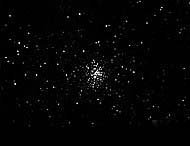 M22
- 3200 ASA - C.W.
M22
- 3200 ASA - C.W. |
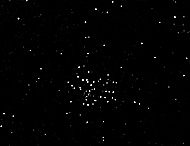 M7
- 3200 ASA - C.W.
M7
- 3200 ASA - C.W. |
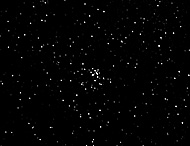
NGC 5281 - 3200 ASA - C.W. |
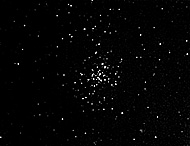
NGC 6231 - 6400 ASA - C.W. |
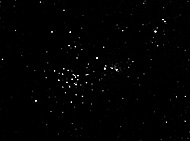
NGC 6530 y M8 - 6400 ASA - C.W. |
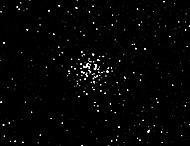
NGC 4755 - 3200 ASA - C.W. |
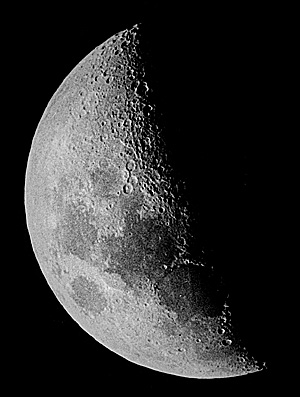 |
One
of the dramatic characteristics of this method is the wide range
of exposure it provides when forcing the film.
I was taking pictures of deep space and decided to force the negative
to 3200 ASA. The Moon appeared almost at the end of the session.
Although I could have cut the negative and processed the shots
in many ways, I decided to shoot the Moon with my camera at automatic
shutter speed.
The range of my Pentax is 1600 ASA, and I had already taken all
the other pictures al 3200 ASA. I decided to shoot anyway!
When developing those pictures, I realized that the shots of the
Moon had come out really good, with a great variety of gray shades,
and they could even be copied without any problem as well, even
though they were a bit darkened.
|
PREPARING
THE CHEMICALS
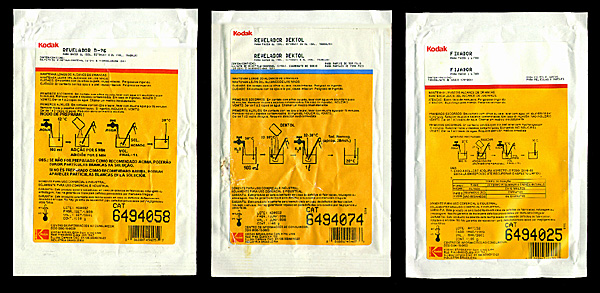
All you need to do is follow the manufacturer�s instructions carefully.
The required solutions are Kodak D-76 Developer and the fixer.
Both come in ready-to-use pouches. To prepare 1 lt. of concentrated
developer, you must heat 900 ml. of water at 52�C. Then add the powder
during 5 minutes, stir until it becomes crystal-clear. After that, pour
the remainding 100 ml. of water at room temperature to complete the
liter. The solution should be stored in dark bottles or accordioned
plastic jars in order to let the air out. It can last a couple of months
when properly stored. The same method applies to the fixer, but the
temperature must be 27�C. This solution can be used several times, either
on negatives or on paper. The paper developer differs from the film
developer. Dektol by Kodak is recommended here. Its preparation
is similar, but the temperature must be 38�C. It produces 3 liters of
solution. The storage time is limited to a short period if not properly
kept. .
HOME
ACCESSORIES TO BE USED.
|
|
For
prime-focus photography with Meade Starfinder telescopes, the
primary mirror should be set to the second position but this action
does not allow to see or focus with eyepieces. To avoid moving
the primary mirror, you will need to make a sepecial ring-shaped
threaded plastic fitting, attachable to the 2" adaptor which comes
as an accessory to the telescope. Then fix it with epoxi glue
to any camera adaptor.
To copy the negatives on paper you can make an amplifier with
a shoe box or any similar box, fix a bulb socket in it with a
75-watt bulb, as well as an electrical wire and switch. You must
make a diffuser in the box, adding a couple of emery glasses or
plastic sheets. Then you must adapt an objective, ideally with
a diaphragm and a wide focal length range. The negative frame
can be made with 2 cardboard sheets which will be inserted in
a slot carved in front of the objective.
|
As
you can see, with little money and a bit of creativity, you can produce
good shots from your own backyard, reaching a magnitude of 13.5 in city
skies. Yet, you may require some more accurate devices and some 1-minute
exposures to shoot God arguing with The Devil at the bottom of the Universe...
Less
is More ...
Architect
Cristian Willemo�s
[email protected]
[email protected]
www.geocities.com/cwillemoes
Titular Associate Professor - UCALP
Practical Works Chief - UNLP
Principal Professional - Physics Institute La Plata - IFLP - CONICET
Section Coordinator: CCDs - Iberoamerican Astronomy League - LIADA
Translated into English by Alejandra De Gennaro
[email protected]
- [email protected]